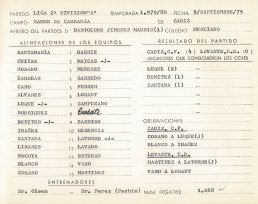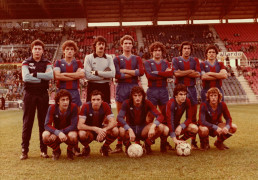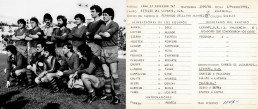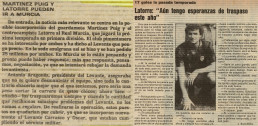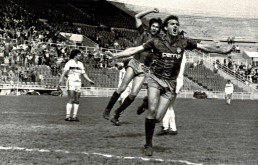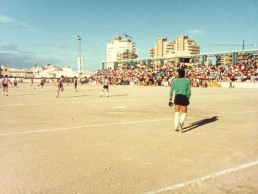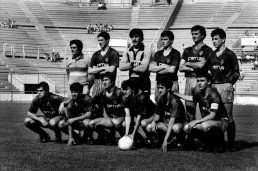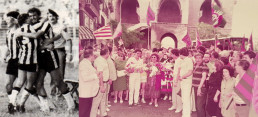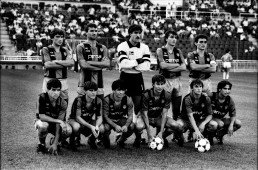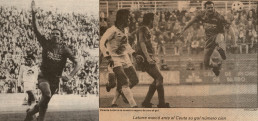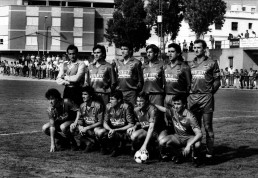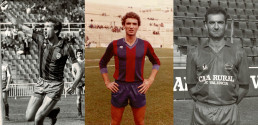Juanito Puig, Koné, Calpe, Morales, Ballesteros, Domínguez, Juanfran, Dolz, Ettien, Iborra… What do all these players have in common? Well, they are probably never missing from the lists that the good fans of Orriols draw up when someone asks them who have been the best Levante footballers of all time… Although of course… In this plethora of Azulgranas icons, everyone will have realised that someone is missing, that we have left out a legend, an essential in the Olympus of the Granotes’ gods: Vicente Latorre Bolea. That is, Latorre. Or simply Lato. Nothing more. And nothing less.
Vicente or Vicent (because Latorre is a Valencian through and through) was born very close to the Malvarrosa beach in Valencia, a stone’s throw from the house of his famous namesake, the brilliant writer Vicente Blasco Ibáñez. When he was a child, his family moved to Tavernes Blanques and from very early on he showed that he was not only enthusiastic about football but that he had been touched by the wand of the chosen ones to succeed in this sport. As there was no federated team in his village, he went on to play for the children’s team in neighbouring Meliana, when he was a juvenile. And then the whole squad moved on to the youth team, when he was a child. He then joined Moncada and, from there, a scout took him to play for Valencia Infantil. After his move to the club’s youth team and not feeling comfortable in that new project, Marítimo de La Malvarrosa became interested in him and, after reaching an agreement with Latorre and his father, he signed for that team to return home. What he didn’t know at first was that that team was a subsidiary of Levante UD and that he had just joined the club of his life.
A record for the history of Levante. Latorre’s debut, at the age of 18, with the Levante UD first team. It was on 9 September 1979 at the Ramón de Carranza stadium in Cádiz.
So, logically, he immediately became part of the Levante youth team which, at that time, was playing in the División de Honor of Spanish football. It didn’t take him long to become the team’s main reference point and from that period he fondly remembers great matches played on the Levante UD’s grassroots football pitch in La Malvarrosa. Among them was a fantastic victory over Barça’s youth team, which was led by the legendary striker Lobo Carrasco. And although his debut with the first team was in the 1979/80 season in a match in Cádiz, it was from 1980/81 when he began to play regularly as a starter. This was also helped (despite the undoubted quality he possessed) by the federative rule which, at that time, obliged all teams in the Second Division to field two U-20 players in the starting eleven.
The 1980-81 season was the first in which Latorre was a regular starter. From left to right and from top to bottom Manolo (kit man), Agustín, Barrie (goalkeeper), Latorre, Lorant, Varó, Sierra, Pousada, Floro Garrido, Campuzano, Eulate and Óscar.
And what are the things of destiny. In his first season in the first team (and at just twenty years of age) he was to share a dressing room with one of the greatest footballers of all time. But before that happened, and under the guidance of coach Pachín, Levante UD had a spectacular first half of the season and became the great revelation of the season. After a 2-0 win over Burgos in the first game of the second half of the season, the Granotes were the sole leaders of the category. The dream of returning to the First Division seemed feasible and, then, the president Francisco Aznar decided to pull a rabbit out of the hat and announced an extraordinary reinforcement to achieve it: the signing of the Dutch footballer Johan Cruyff, one of the best players in the history of the sport. The commotion among the fans and the staff of the Orriols club was extraordinary.
Lato & Cruyff. On the left in training with the Spanish-Brazilian defender Gómez. On the right in the Dutchman’s debut match on 1 March 1981.
On the left, the eleven of the first match Cruyff played as a Granota on the day they beat Palencia 1-0. From left to right and from top to bottom: Agustín, José, Barrie (goalkeeper), Lavado, Lorant, Latorre, Sierra, Pousada, Peregrín, a child posing, Cruyff and Campuzano. On the right the record of that match
Latorre remembers that he will never forget it as long as he lives. And that just being able to share with such an exceptional player the day to day training sessions impressed him. As, of course, were the Granotes fans who flocked to watch them. In fact, Vicente claims that on numerous occasions more fans gathered at those training sessions than at many official matches in the league seasons of that difficult decade of the eighties that he lived through in its entirety. Because that bizarre Cruyff story ended up turning out to be a sporting and economic fiasco (to such an extent that the staff had to lock themselves in the dressing room in protest against non-payments) that led Levante to wander for years in a desert of secondary categories.
After finishing the Dutchman’s year in ninth position, the 1981/82 season was the confirmation of the return to the hard reality of the Levante team. The team did not work and, after a brief spell on the bench by Vicente Piquer and Antonio Calpe, coach Roberto Gil took over the technical direction from the seventh matchday at the end of that disastrous league championship which ended with a double relegation from the category. Firstly in sporting terms, after finishing in second to last position, and secondly financially, due to non-payments and debts. Latorre did not play a single match during the whole of that campaign in the silver division because he was doing his military service. So when he returned to Orriols in 1982/83 he went from playing against Rayo Vallecano to playing against Paterna.
However, that year and while he was still so young, his leadership was already unquestionable. He became the team’s top scorer (despite not being a striker) and immediately made his virtues clear: he was an attacking inside midfielder who played on both flanks with equal fluency. Thanks to his physical prowess and large wingspan, he was able to get from the back to the far post and that made it extremely easy for him to find the back of the net. If you added to all of this his enormous quality on the ball and a devastating shot from outside the area, it was clear that Lato was predestined to become an out-and-out player. And that is what happened. At the end of that campaign Levante qualified for the promotion playoff to Segunda B, although the play-off against Ensidesa from Asturias proved to be a failure. After losing 2-0 in Avilés, a 1-0 win in the return leg was not enough to complete the comeback. That goal in that futile victory in Valencia was scored by Latorre who, on a personal level, thus ended an extraordinary season. So much so that, at its conclusion, he was on the verge of being signed by Murcia to play the following season in the First Division. But, fortunately for the history of the Orriols club, that did not happen.
On 29 May 1983 Levante UD wore an all orange kit for the first leg of the promotion play-off against Ensidesa in Avilés. From left to right and from top to bottom Martínez Puig (goalkeeper), Cotino, Segura, Gimeno, José, Toni, Víctor, Latorre, Luis, Domingo and Claudio.
At the end of the 1982/83 season and due to his excellent season, Murcia (who had been promoted to the First Division after winning the Second Division) was on the verge of signing Latorre but, in the end, the operation did not come to fruition.
Levante were determined not to fail again the following season and finally return to the bronze category. Moreover, that season was special as it was the 75th anniversary of the birth of the club. If they wanted to reach the playoffs, they had to finish in the top two. And the Granotes were runners-up in Group VI of the Third Division behind a spectacular Alzira side that finished eight points ahead of the Orriols side. The season was not a quiet one, however. At the club presided over by Antonio Aragonés, promotion was a must, and the general nervousness precipitated a change of coach in April 1984. Pepe Martínez was replaced by Manolo Tatay and he was entrusted to lead the Granotes to an already essential promotion.
On 18 March 1984, Levante won 2-0 against Alzira, the eventual champions that season. Latorre celebrating his goal (the other was scored by Albiol, here behind him).
The climax of the season arrived and Latorre was once again decisive when everything was at stake. The first playoff tie was played against Fuengirola. On Andalusian soil, Levante could only draw 0-0, but in the second leg at the Ciutat, the Azulgranas crushed the Malagueños 6-1. In that overwhelming victory, Vicente was the main scorer with a brace.
Image of the 0-0 draw achieved in Fuengirola by Levante UD in the first leg of the first play-off for promotion to Segunda B in the 1983-84 season. In the foreground, goalkeeper Martínez Puig on the dirt pitch in Fuengirola. On that day, the Orriols players were dressed in black and white.
And so the final round was reached, which the Granotes had to overcome if they wanted to become a new Segunda B team. The opponent was Orense, a very complicated team, full of experience and that, in addition, would have the great advantage of playing the second game at home. In the first leg at the Ciutat de València, Levante won by the minimum thanks to the only goal scored by a very young Claudio Barragán, who two years later would explode at national level and would be signed by Elche to play in the First Division. Five days after that victory, on Friday 22 June 1984, the Granotes faced the return leg in Galicia. And on the D-day and at the H-hour Vicente Latorre was once again crucial. In a packed O Couto stadium in Orense, the player from La Malvarrosa scored the goal that allowed Levante UD to draw that match to one and be promoted to the bronze category of Spanish football.
XI from the first leg (held in Valencia) of the decisive play-off against Orense. From left to right and from top to bottom, coach Manolo Tatay, Cotino, Martínez Puig (goalkeeper), Segura, Latorre, Claudio, Gómez, Zapata, Albiol, Domingo, Alonso and Toni.
Two magical photos of that promotion to Segunda B. On the left Latorre hugging Óscar after scoring the decisive goal in Orense (with Claudio in the background) and on the right in the celebrations with the fans in the Torres de Serranos de València (in the centre the captain Toni with the great Levantinista Lola Fos de Boluda).
In 1984/85, Levante had a more than acceptable season in Segunda B and finished mid-table, in eleventh position. Latorre was once again the team’s top scorer, with 12 goals, and on the penultimate matchday, at the Carlos Belmonte stadium in Albacete, he became the star of the match. Despite the fact that the Granotes no longer had anything to play for, unlike the La Mancha side, who, if they won, would mathematically seal their promotion, the Levantines won 2-4. And Vicente was the author of a spectacular hat trick that almost ruined the home side’s aspirations. However, in the end they were promoted (the first two teams to go up) despite being level on points with the third and fourth placed teams.
The 1984/85 season saw the consolidation of Levante UD in the bronze category of Spanish football. In the picture, the eleven that drew 2-2 against Orihuela on 2 September 1984 at the Ciutat de València. From left to right and from top to bottom: Agustín, Latorre, Martínez Puig (goalkeeper), Segura, Toni, Claudio, Nando, Zapata, Albiol, Óscar and López Ufarte (Alejandro).
However, in the 1985/86 season, Levante UD was relegated again to the Third Division. But not because of sporting demerits but because of a restructuring of the category. The two Segunda B groups were merged into one, and that meant that the last thirteen teams in each of the two out of twenty were relegated. The Blue and Whites finished tenth, just three points behind Granada, who were the last team to be saved in seventh place. That year, Latorre took over the captain’s armband (which he had already worn in some matches the previous season) and would not relinquish it until the end of his career as a Granota.
In 1985/86 Levante, despite being tenth, were relegated to Tercera due to a restructuring of the Segunda B league. In the two images, Latorre shooting at the rival goal and celebrating a goal at the Ciutat de la Ciutat
Vicente Latorre’s 1986/87 season was extraordinary. It was, by far, his best goalscoring campaign in the blaugrana shirt. With an absolutely astonishing scoring average. In 28 games played, he scored 24 goals, almost a goal per game. And he was not only limited to scoring braces or a hat trick, he even scored four in an unforgettable match against Algemesí.
In 1986/87 Latorre reached his zenith as a Granota goalscorer with 24 goals. In December 1986 he scored a brace in a 3-0 win against Alicante. In the pictures celebrating (in the goal of the Orriols goal) one of his two goals that day.
In 1986/87 there was one team that suffered more than anyone else from Latorre’s goal-scoring fury. Algemesí conceded as many as six goals that season. In the 0-3 win in the Ribera Alta town, the player from La Malvarrosa scored two (in the picture above scoring and celebrating one) and in the second leg at the Ciutat he scored a hat-trick, scoring all four goals in the victory that day (below).
And at the end of that superlative season under Latorre, Levante also returned to Segunda B. A new restructuring of the division benefited (at last) the Granotes. The top five teams were automatically promoted to the bronze category of Spanish football, which now had 80 teams divided into four regional sub-groups. The Orriols side, who had finished second under coach Alfonso Nebot, joined the Segunda B Group IV. And they did so alongside Third Division champions Olímpic de Xàtiva, plus Villarreal, Benidorm and Mestalla.
In the 1987/88 season (the Azulgranas were placed in the Valencian/Andalusian group) Levante finished sixth and it was Alzira who were promoted (only the first team to do so) to the Second Division. Latorre was once again the top scorer, scoring 18 goals in another fantastic campaign, but it was clear that the Orriols side’s objective was to climb to the silver division the following year. The club’s survival depended on it.
But it was not going to be easy. Only the champion had a prize, and that 1988/89 season, in Group IV of Segunda B, there were clubs as powerful as Villarreal, Hércules, Alcoyano, Albacete and Granada. But, surprisingly, it was Ceuta who became the great revelation and with whom the team from Orriols had to fight the hardest to achieve the desired promotion.
That head-to-head with the North African side ended in a goalless draw in Ceuta and a spectacular 5-4 win at the Ciutat de València. On that day, Vicente Latorre was a masterful player, scoring a brace and his 100th goal as a Levante player. And another fact that gives even more merit to that mythical goal that paved the way for promotion to the Second Division. Manolo, the goalkeeper of the club from the autonomous city, had not conceded more than two goals in any game that season and that day he had to pick the ball out of his net five times.
On 12 February 1989, Levante beat Ceuta 5-4 (with two goals from Latorre) and got on track for promotion to the Second Division.
After that decisive victory, Levante became the main candidates for promotion and led the competition with authority until they achieved it. In fact, the Blue and Reds, led by coach Roberto Álvarez, secured promotion with four games to go. The Granotas visited a hopeless Nules and the victory gave them the glory. The team could not fail and won in an uncontested manner by 0-3. And, of course, Latorre scored again on a historic day for Levante, accompanying his teammate Corbalán, who scored a brace that day.
On 4 June 1989, Levante UD was promoted to Second Division after defeating Nules by 0-3, with two goals from Corbalán and another from Latorre. In the picture the eleven of that day. From left to right and from top to bottom: Museros (goalkeeper), Abad, Aragó, Susaeta, Martín, Latorre, Patri, Corbalán, Verde, Ballester and Blesa.
The 1989/90 season was the last season in Orriols for the great granota captain. And after eleven seasons, he came full circle, ending his career in the same category in which he started it: the second division of Spanish football. The team finished in fifteenth position under the orders of Pepe Martínez, an old acquaintance of the club who took over from coach Roberto Álvarez in the last quarter of the competition. And the final point (of that boy who was born in La Malvarrosa and became a Levante legend) was put by Latorre with two devastating statistics that are still valid today. He is the top scorer in the history of the oldest club in the Valencian Community with 113 goals. And he is the third player (after Dolz and Ettien) with the most games ever played in the Levante jersey since the Levante FC-Gimnástico merger in 1939.
Vicente Latorre never played for Levante UD in the First Division, he was never able to play for his beloved team in the elite of Spanish football. But that will never detract one iota from the marvellous legacy he has left behind in Orriols. Because if this extraordinary midfielder had not been the anchor and bulwark of Levante in those very difficult years of the 1980s, when the club had barely three or four thousand members, who knows what would have become of this club, which until well into the 21st century did not reach the best stage of its history.
At the end of his time with the club, Latorre received a letter from the then president Ramón Victoria in which, on behalf of all Levante supporters, he thanked him from the bottom of his heart for his memorable career and let him know that the club wanted to present him with the insignia de oro y brillantes and also dedicate a tribute match to him. In the end, due to various circumstances, this could not take place. It would be lovely if, one day, that promise would come true.
Vicente Latorre has been, without a doubt, one of the best Levante UD players of all time.
